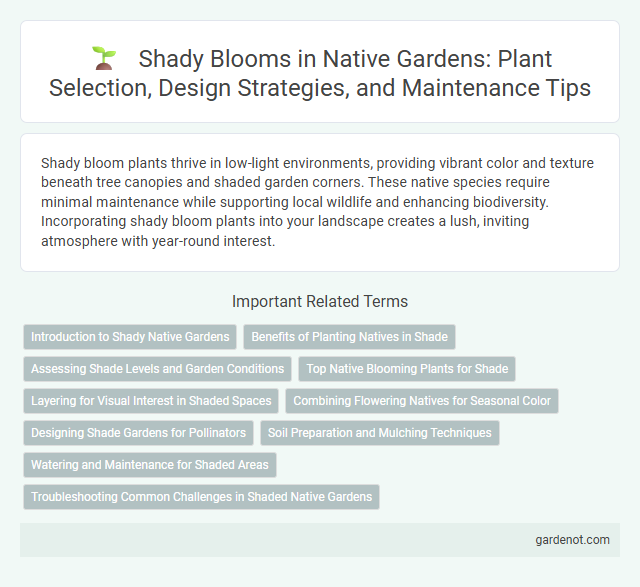Shady bloom plants thrive in low-light environments, providing vibrant color and texture beneath tree canopies and shaded garden corners. These native species require minimal maintenance while supporting local wildlife and enhancing biodiversity. Incorporating shady bloom plants into your landscape creates a lush, inviting atmosphere with year-round interest.
Introduction to Shady Native Gardens
Shady native gardens feature plant species adapted to low-light conditions, promoting biodiversity and ecological balance in shaded areas. Key species include ferns, trilliums, and wild ginger, which thrive under tree canopies and provide habitat for pollinators and wildlife. Integrating native shade plants helps maintain soil health, reduce erosion, and support local ecosystems sustainably.
Benefits of Planting Natives in Shade
Shady bloom plants thrive in low-light conditions, making them ideal for native planting in shaded areas. These plants improve soil health by enhancing biodiversity and supporting local pollinators through specialized nectar sources. Native shade plants also require less water and maintenance, promoting sustainable landscaping with natural ecosystem benefits.
Assessing Shade Levels and Garden Conditions
Shady bloom thrives in environments with low to moderate sunlight, making it essential to accurately assess shade levels before planting. Evaluate the garden's canopy density, surrounding vegetation, and daily sunlight exposure to ensure optimal growth conditions. Soil moisture and drainage also impact the success of shady blooms, requiring well-drained yet consistently moist soil for vibrant flowering.
Top Native Blooming Plants for Shade
Top native blooming plants for shade include Trillium, which thrives in moist, wooded areas, offering striking white flowers that attract pollinators. Virginia Bluebells provide vibrant blue-purple blooms in early spring, supporting early-season bees and butterflies. Foamflower grows well in shaded gardens, producing delicate white clusters that enhance biodiversity and soil health.
Layering for Visual Interest in Shaded Spaces
Shady bloom plants thrive in low-light environments, creating vibrant layers that enhance visual interest in shaded garden spaces. Incorporating a mix of native ferns, hostas, and woodland wildflowers adds texture and depth, promoting biodiversity and sustainability. Layering these shade-loving species supports natural ecosystem functions while providing year-round appeal with varied foliage and seasonal blooms.
Combining Flowering Natives for Seasonal Color
Shady bloom thrives when combining flowering natives like Trillium, Virginia Bluebells, and Foamflower, providing vibrant seasonal color from spring to early summer. These shade-loving plants support pollinators and enhance woodland garden aesthetics with their diverse blooms and foliage textures. Integrating these species creates a dynamic, low-maintenance planting that adapts well to varying shade conditions and soil types.
Designing Shade Gardens for Pollinators
Designing shade gardens for pollinators involves selecting native plants like Shady Bloom, which thrives in low-light environments while providing essential nectar and habitat. Incorporating species with varying bloom times ensures continuous food sources for bees, butterflies, and other pollinators throughout the growing season. Utilizing Shady Bloom enhances biodiversity and supports ecosystem health by attracting native pollinators to shaded garden areas.
Soil Preparation and Mulching Techniques
Shady bloom thrives best in well-drained, loamy soil enriched with organic matter to promote healthy root development. Effective soil preparation involves loosening the soil to a depth of at least 12 inches and incorporating compost or aged mulch to enhance moisture retention and nutrient availability. Applying a 2-3 inch layer of organic mulch, such as shredded leaves or bark, helps regulate soil temperature, suppresses weed growth, and maintains consistent soil moisture essential for shady bloom's vigorous growth.
Watering and Maintenance for Shaded Areas
Shady bloom plants thrive with consistent moisture, requiring watering that keeps the soil evenly damp but not waterlogged to prevent root rot. Mulching around these plants helps retain soil moisture and moderates temperature fluctuations, promoting healthy growth in shaded environments. Regular pruning removes dead or crowded stems, enhancing airflow and reducing disease risk in shaded garden beds.
Troubleshooting Common Challenges in Shaded Native Gardens
Shady native gardens often face challenges such as poor soil drainage, insufficient light, and competition from invasive species that hinder plant growth. Selecting shade-tolerant native plants like trilliums, foamflowers, and wild ginger can improve garden resilience by thriving in low-light conditions and enhancing biodiversity. Regularly monitoring soil moisture and controlling invasive plants through mulching and manual removal supports healthier root systems and reduces disease risk in shaded environments.
Shady bloom Infographic

 gardenot.com
gardenot.com